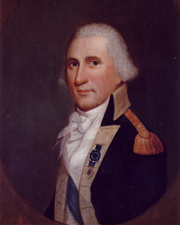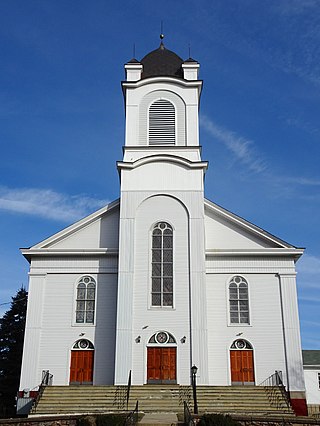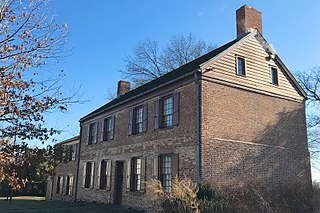
The Delaware and Raritan Canal is a canal in central New Jersey, built in the 1830s, that connects the Delaware River to the Raritan River. It was an efficient and reliable means of transportation of freight between Philadelphia and New York City, transporting anthracite coal from eastern Pennsylvania during much of the 19th and early 20th centuries. The canal allowed shippers to cut many miles off the existing route from the Pennsylvania Coal Region down the Delaware, around Cape May, and up the occasionally treacherous Atlantic Ocean coast to New York City.

Frederick Frelinghuysen was an American lawyer, soldier, and senator from New Jersey. A graduate of the College of New Jersey, Frederick went on to become an officer during the American Revolutionary War. In addition, he served as a delegate to the Continental Congress. He was a United States Senator from New Jersey from 1793 until 1796, and served as the United States Attorney for the District of New Jersey in 1801.

Theodore Frelinghuysen was an American politician who represented New Jersey in the United States Senate. He was the Whig vice presidential nominee in the election of 1844, running on a ticket with Henry Clay.

Jacob Rutsen Hardenbergh was an American Dutch Reformed clergyman, colonial and state legislator, and educator. Hardenbergh was a founder of Queen's College—now Rutgers, The State University of New Jersey—in 1766, and was later appointed as the college's first president.
Frelinghuysen is a surname of Dutch origin. Several of its members formed the Frelinghuysen family of New Jersey politicians. It may also refer to:

Theodorus Jacobus Frelinghuysen was a German-American Dutch Reformed minister, theologian and the progenitor of the Frelinghuysen family in the United States of America. Frelinghuysen is most remembered for his religious contributions in the Raritan Valley during the beginnings of the First Great Awakening. Several of his descendants became influential theologians and politicians throughout American history.

The Willow Grove Cemetery in New Brunswick, New Jersey is located behind the New Brunswick Free Public Library and the Henry Guest House. The cemetery runs along Morris Street, from Livingston Avenue to George Street. It is a contributing site of the Livingston Avenue Historic District.

John Frelinghuysen also known as Johannes Frelinghuysen was a minister in colonial New Jersey whose work in education laid the groundwork for the establishment Rutgers University and the New Brunswick Theological Seminary.

The Mary Ellis grave is a grave located behind an AMC Theatre on U.S. Route 1 in New Brunswick, Middlesex County, New Jersey, United States. The granite gravestone is located on a 7-foot (2.1 m) high stonework pyramid in the back parking lot. Seven relatives are also buried and marked on the grave itself.
Six Mile Run is an unincorporated community and census-designated place (CDP) located in Franklin Township, in Somerset County, in the U.S. state of New Jersey. As of the 2010 United States Census, the CDP's population was 3,184.
Rutgers University is an institution of higher learning with campuses across the State of New Jersey its main flagship campus in New Brunswick and Piscataway, and two other campuses in the cities of Newark and Camden, New Jersey.
The Frelinghuysen family is an American political dynasty, primarily based in New Jersey, that first emigrated from The Netherlands in 1720.

Readington Village is an unincorporated community located within Readington Township in Hunterdon County, in the U.S. state of New Jersey, that is centered on the converging of Readington Road, Hillcrest Road, Centerville Road and Brookview Road. It is located on Holland Brook, originally named Amanmechunk, which means large creek in the Unami dialect. The area was inhabited by the Raritan prior to the arrival of European settlers. The Native Americans who lived near Readington Village travelled to the coast during the summer for fish and clams. Such a trip is mentioned in an Indian deed transferring lands around Holland Brook to George Willocks, an East and West New Jersey Proprietor. The deed mentions two of the natives, who lived at Readington: Metamisco and Wataminian.

Mile Run is a tributary of the Raritan River in New Brunswick, New Jersey, in the United States.

The Six Mile Run Reformed Church is located at 3037 New Jersey Route 27 in Franklin Park of Franklin Township, Somerset County, New Jersey, United States. Built in 1879, it was added to the National Register of Historic Places on December 18, 2009, for its significance in architecture and music.

The General John Frelinghuysen House is a historic building located in Raritan, New Jersey. The older west wing was originally a tavern, built sometime before 1756 by Cornelius Bogert, when it also served as the town's meeting hall. It was bought in 1801 by John Frelinghuysen and then came to be known as the Frelinghuysen Homestead. It is an excellent example of early 19th century Federal architecture in New Jersey. In 1975, it was donated by Peter Frelinghuysen, Jr. to the borough and now serves as the Raritan Public Library.

The Readington Reformed Church is a historic church located at 124 Readington Road, Readington Village, an unincorporated community located within Readington Township in Hunterdon County, New Jersey. It was known in colonial times as the Dutch Reformed Church of North Branch. It is the oldest Dutch Reformed Church in the county. The current building was built in 1865. The churchyard is known as the Readington Reformed Church Cemetery. The church was added as a contributing property of the Readington Village Historic District by the National Register of Historic Places on June 24, 1991.

The Van Veghten House is a historic building in the Finderne section of Bridgewater Township, New Jersey. It was built around 1725 and served as the headquarters of Quartermaster General Nathanael Greene during the second Middlebrook encampment (1778–79) in the American Revolutionary War. The Somerset County Historical Society owns the house and uses it as its headquarters, including a museum and library. The early 18th-century Old York Road passed by here connecting Philadelphia to New York City. The house was added to the National Register of Historic Places on October 10, 1979 and noted as representing "one of the few remaining Raritan River mansions".
Domine Johannes Arondeus was one of the earliest pastors in American history who was sent to the Middle Colonies during the height of the First Great Awakening by the Dutch Church in Holland. The purpose of the Great Awakening was Evangelism and it adopted the evangelical style of preaching that held conservative theological views believing in the Bible as the word of God.
















